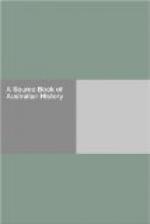WAKEFIELD’S SCHEME OF COLONIZATION
+Source.+—A Letter from Sydney. E.G. Wakefield (Gouger, 1829), Appendix
The failure of the first attempt to settle Western Australia gave rise to much thought upon the theory of colonization. The ideas most generally accepted were those of Edward Gibbon Wakefield, who summarized his theory as follows:
OUTLINE OF A SYSTEM OF COLONIZATION
It is suggested:
Article I.
THAT a payment in money of—— per acre, be required for all future grants of land without exception.
Article II.
THAT all land now granted, and to be granted, throughout the colony, be declared liable to a tax of—— per cent. upon the actual rent.
Article III.
THAT the proceeds of the tax upon rent, and of sales, form an EMIGRATION FUND, to be employed in the conveyance of British labourers to the colony free of cost.
Article IV.
THAT those to whom the administration of the Fund shall be entrusted, be empowered to raise money on that security, as money is raised on the security of parish and county rates in England.
Article V.
THAT the supply of labourers be as nearly as possible proportioned to the demand for Labour at each Settlement; so that Capitalists shall never suffer from an urgent want of Labourers, and that Labourers shall never want well-paid employment.
Article VI.
THAT in the selection of Emigrants, an absolute preference be given to young persons, but that no excess of males be conveyed to the colony free of cost.
Article VII.
THAT Colonists providing a passage for emigrant Labourers, being young persons, and equal numbers of both sexes, be entitled to a payment in money from the Emigration Fund, equal to the actual contract price of a passage for so many labouring persons.
Article VIII.
THAT Grants be absolute in fee, without any condition whatever, and obtainable by deputy.
Article IX.
THAT any surplus of the proceeds of the tax upon rent and of sales, over what is required for Emigration, be employed in relief of other taxes, and for the general purposes of Colonial Government.
FOUNDATION OF SOUTH AUSTRALIA
+Source.+—Six Months in the new Colony of South Australia (J. Horton James, 1839), pp. 1, 28-37
The settlement of South Australia was undertaken to test Wakefield’s theory; but instead of turning their land to good account the colonists left it idle, hoping to sell at a high price. The result was disastrous.
SITUATION AND EXTENT
The New Province, called South Australia, which, by an Act of the Imperial Parliament, was erected into a free British colony on 15th August, 1834, is situate on the South Coast of the Great Island Continent of New Holland, in the Southern or Indian Ocean, extending from 132 deg. to 141 deg. E. longitude, and from 38 deg. to 26 deg. S. latitude, and contains nearly two hundred millions of acres. It is twelve thousand miles distant from Great Britain.




